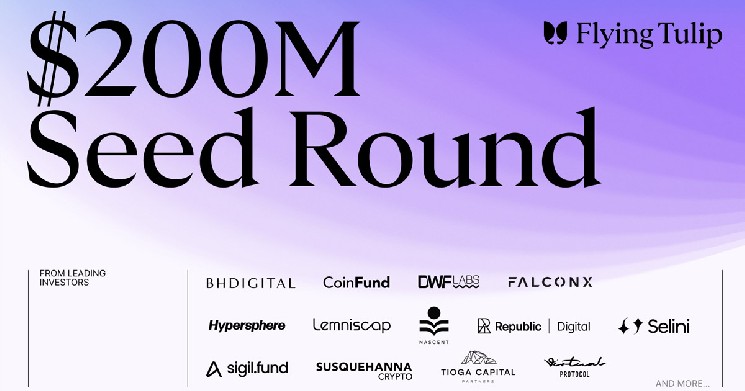Flying Tulip Secures $200 Million in Private Funding, Announces Public Token Sale with Innovative Redemption Mechanism
Revolutionary Onchain Exchange Platform Offers Unprecedented Capital Protection Through “Perpetual Put” Design
In a significant development for the cryptocurrency and decentralized finance space, Flying Tulip has announced securing $200 million in a private funding round, establishing itself as a formidable player in the onchain exchange marketplace. The full-stack exchange platform revealed plans to extend the same valuation terms to public investors through an upcoming onchain sale of its $FT token, targeting a potential combined raise of up to $1 billion across both funding phases.
Flying Tulip distinguishes itself in the increasingly crowded cryptocurrency exchange landscape by integrating multiple financial instruments within a single, cross-margin system. The platform combines a native stablecoin, money market, spot trading capabilities, derivatives, options, and onchain insurance in what it describes as a “volatility-aware system designed for capital efficiency.” This comprehensive approach aims to address the fragmentation often experienced by traders navigating between different platforms for various financial needs in the digital asset space.
The private funding round attracted an impressive roster of established investment firms with significant blockchain and cryptocurrency expertise. Notable participants include Brevan Howard Digital, a division of the global alternative asset management firm; CoinFund, known for its early investments in leading blockchain projects; DWF; institutional trading platform FalconX; Hypersphere; Lemniscap; Nascent; Republic Digital; Selini; Sigil Fund; Susquehanna Crypto; Tioga Capital; and Virtuals Protocol. The diversity and caliber of these investors signal strong institutional confidence in Flying Tulip’s approach and market positioning.
Groundbreaking “Perpetual Put” Mechanism Offers Unique Downside Protection
Perhaps the most innovative aspect of Flying Tulip’s funding structure is its onchain redemption right, described as a “perpetual put” option. This mechanism provides both private and public sale participants with the ability to burn their $FT tokens at any time and redeem up to their original principal investment in the asset they initially contributed, such as Ethereum (ETH). This redemption process is not merely a contractual promise but is programmatically enforced through smart contracts, with redemptions settled from a segregated onchain redemption reserve specifically established from the capital raised.
“Our goal is to provide institutional-grade market structure with onchain guarantees and clear alignment between users, investors, and the team,” said Andre Cronje, founder of Flying Tulip, highlighting the platform’s focus on transparency and risk management. The perpetual put mechanism represents a groundbreaking approach to investor protection in the cryptocurrency space, where early investors have historically been subject to significant volatility without recourse. By offering this downside protection while preserving unlimited upside potential, Flying Tulip creates a more balanced risk profile that may appeal to institutional investors previously hesitant to enter the cryptocurrency market.
Novel Tokenomics Model Aligns Team Incentives with Platform Success
Flying Tulip further differentiates itself through its tokenomics model, which departs significantly from industry norms. Rather than allocating a substantial portion of tokens to the founding team and early employees—a common practice in cryptocurrency projects—Flying Tulip’s team receives no initial allocation. Instead, team exposure to the token will accrue exclusively through open-market buybacks funded by a share of protocol revenues, subject to a transparent schedule disclosed to the public.
This approach creates direct alignment between the team’s financial interests and the platform’s long-term performance and usage. By tying incentives to actual protocol revenue rather than token price appreciation alone, Flying Tulip encourages sustainable development and discourages short-term token price manipulation that has plagued many cryptocurrency projects. This model represents a maturation in token economics that may set a new standard for projects seeking to demonstrate serious long-term commitment to their platforms and users.
Public Sale Structure and Platform Positioning
The upcoming public sale will be conducted onchain across multiple blockchain networks, though specific details regarding supported assets, initial circulating supply, and sale mechanics are yet to be announced. The company has emphasized that official smart contract addresses for the sale will be published exclusively on its official website ahead of the launch, likely a precautionary measure against the increasing prevalence of cryptocurrency scams that mimic legitimate token sales.
As a comprehensive onchain financial marketplace, Flying Tulip positions itself at the intersection of traditional finance and decentralized technologies. By unifying spot trading, derivatives, credit facilities, and risk transfer mechanisms within a capital-efficient, cross-margin system, the platform aims to reduce the friction currently experienced by traders who must manage positions across multiple platforms and manage complex collateral requirements independently. The emphasis on transparent risk management and long-term sustainability suggests a focus on institutional adoption and regulatory compliance that has often been lacking in earlier cryptocurrency projects.
Flying Tulip’s approach comes at a time when regulatory scrutiny of cryptocurrency exchanges is intensifying globally, with authorities increasingly concerned about investor protection, market manipulation, and systemic risk. By building in programmatic protections and transparency mechanisms from inception, Flying Tulip appears positioned to navigate this evolving regulatory landscape while delivering innovative financial services on decentralized infrastructure. As the platform moves toward its public token sale and eventual full launch, it represents an important experiment in combining institutional-grade financial products with the transparency and programmability afforded by blockchain technology—potentially bridging the gap between traditional finance and the emerging decentralized economy.


